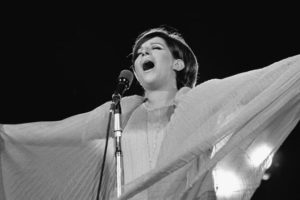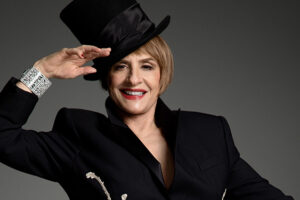

If Barrie Kosky‘s production of West Side Story (seen May 8th) looks better in still pictures than it does in the theater, that’s not so much a criticism of his direction as praise for its boldly visual quality. The writhing young bodies on stage, enveloped in light and fog, could almost be a shoot for a line of upscale activewear, with all the steamy homoeroticism that implies. Those were some very hot Jets and Sharks.
The approach is not particularly radical: Kosky sensibly sets a piece that was originally “modern” in a contemporary setting; that is, in the early 21st century instead of the quaint 1950s. People wear a lot of black when they wear a lot of anything, which is not all the time because the guys keep stripping off their shirts, revealing extravagant tattoos across ripped chests.
The action takes place in a black void, with the brick back wall of the theater visible. Lighting instruments fly in and out, and as the show progresses the stage is increasingly filled with smoke and mist. On the black floor are lines suggesting a basketball court, with a circle outlining the stage revolve that moves between scenes mostly without going “in one.”
This is definitely a “big house” take on West Side Story: I counted 54 in the ensemble and I estimated 60 in the pit. The very large chorus divides the labor between dancing and singing, with the hoofers almost constantly in motion during the musical numbers and members of the company’s chorus farther upstage doing simple backup movement. The dialogue is in German, in what sounds like rough Berlin street dialect; I hardly caught a word. But the songs are sung in English, and in a rather fussy English at that, with carefully rounded diphthongs that might be more at home in a Noel Coward operetta. As seems to happen very often when Europeans sing American musical theater, the rhythms are stiffly precise and staccato: “When. You’re a. Jet you’re a. Jet all. The Way.”
That’s a minor issue, though. The show as a whole is quite effective, though it would be more so if the choreography by Otto Pichler were a little more imaginative.
West Side Story is different from most works done in an opera house because it’s not conceived as a text-and-music piece but rather as a dance piece with dialogue and singing. That is to say, the basis of the show is Jerome Robbins‘ direction and choreography; the Leonard Bernstein music and Arthur Laurents‘ book were crafted in support of Robbins’ vision. (I realize this may not be literally true, but at any rate, he was the one who conceived the piece in the first place and the big artistic decisions all seemed to his.
So in a narrow sense a West Side Story without Robbins’ choreography is not really West Side Story at all; rather it’s a different show that happens to use the same text. I would be hypocritical if I said I was opposed to this kind of experimentation (practically everything is worth trying anyway) but if you are going to remove the Robbins then you need to replace it with something comparably interesting.
Pichler’s dances are hugely energetic, based in part on hip-hop moves. The fight scenes crackle with unpredictable violent energy, or at least they start to crackle. But rather quickly the vocabulary turns generic: the Dance at the Gym (a lot of leaping about that looks nothing like a mambo) resembles “America” which could easily be The Rumble.
Each number, then, is thrilling, but there’s little sense of build through the evening. Pichler has the striking idea of introducing an elderly couple doing a ballroom dance during the ballet of “Somewhere”—Tony and Maria celebrating a wedding anniversary sometime in the far future.
But there is no “story” in the ballet as in Robbins, no utopian playground that turns violent. Later, in the finale of the show, there is no “echoing” final image, i.e., the procession bearing Tony’s body as a visual reference to the earlier. Instead, Maria and the dead Tony travel on the revolve upstage until they vanish in the mist. It’s not awful, but it’s not strong either, and, more to the point, it seems to violate the sense that the story is primarily told through dance.
Admittedly, a West Side Story in which dance, or at any rate choreography, is the weak link, is always going to be somewhat hobbled. But this production does benefit from a terrifically energetic cast. The Jets manage to combine grace with masculine vigor: they leap like gazelles but (intentionally) land hard. The Sharks seem never to be at rest, twitching and throbbing and sweating, and the “America” dance for the girls is both sexy and funny.
The show is miked Broadway-style so it’s not easy to judge the voices. Michael Pflumm is a more laid-back Tony than we’re used to seeing, not so much a high school boy as a young adult probably taking night classes at a business college. “Maria” sits very easily in his high tenor, maybe too much so: the high B-flat didn’t register as an event. I would prefer a warmer sound for Maria herself than the light, rather scratchy soprano of Jasmina Sakr, though for an opera/operetta singer she handled the big spoken finale with fine attack.
Robin Poell‘s fireplug Riff and Sigalit Feig‘s tall, blasée Anita are both primarily dancers, smashing ones. Their voices fall a little oddly on American ears used to straight-tone belting; they both have a hoarse, guttural quality that sort of sings in between the notes. “Cool” could almost have been a Kurt Weill cabaret song.
In New York, this show might not play so well, but the Berlin audience in the packed Komische Oper were intensely attentive, audibly gasping at Bernardo’s murder and the moment when Chino finally lets off the gun. That and the enthusiastic applause at the end indicate that Mr. Kosky has crafted his work very well to his intended audience, and even this one of the non-intended found the evening well-spent.

An interesting touch is that the opera in general is sung in German translation, but the “strangers” sing Italian in public, e.g., in Guglielmo’s “Non siate ritrosi.” I liked the fantastic idea that the visitors are displaced not in place but in time, as if to illustrate the famous expression “The past is a foreign country: they do things differently there.” Eventually the women play dress-up in robes a l’anglaise and white wigs too.
The problem is, that’s about where the direction by Alvis Hermanis stopped, i.e., at the conceptual stage. Despite a huge two-story set with supers onstage throughout doing art restoration, what little action transpired was confined to a tiny area downstage, on and around two ugly white sofas. A slide projector operated by Don Alfonso threw images of romantic and erotic art onto screen, and that was about it, until Despina (a heavily pregnant cleaning woman) went into labor during the second act finale.
Of the singers, Lars Møller, the Guglielmo, brought a big, robust voice and some welcome, if generalized energy into the sleepy proceedings. His Italian, though, bore a heavy German accent, as did the rest of the cast’s. (I realize that the Komische’s mission, and a very admirable one it is too, is to offer most of its repertoire in the vernacular, but if you’re going to mix in some Italian, it needs to be better coached than this.)
The scheduled Dorabella was ill, so Maria Markina read the part from a score (singing mostly in Italian, though she ventured a recit. or two in German) while assistant director Anna Borchers played the role with a verve and energy the rest of the cast might well have emulated. Uwe Sandner‘s conducting, even allowing for the difficult circumstances, dragged listlessly. If you’re going to give a performance this dull, then it’s a particularly bad idea to set in in a location where there is literal paint drying.
Photos: Iko Freese/drama-berlin.de (West Side Story); Monika Rittershaus (Così)
-
Topics: barrie kosky, komische oper
Latest on Parterre
parterre in your box?
Get our free weekly newsletter delivered to your email.























Comments